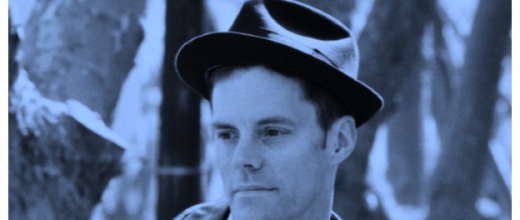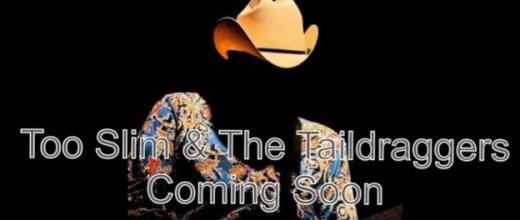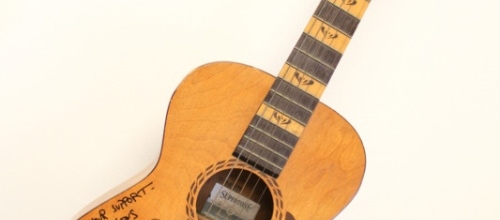Category: news
-
18Dec2014
- share:
-
17Dec2014
- share:
500 Words with Adam P Hunt- Paul Bigsby

Adam P Hunt is a freelance writer who has previously written for The Library Journal and Premier Guitar Magazine. We are so happy to have him join us here at Guitar Radio Show.com.
500 Words on Paul Bigsby
If you’ve ever played a guitar with tremlo system on it you have a lot to thank Paul Bigsby for. Paul Bigby (1899-1968) was a master craftsman and once boasted “I can fix anything!”
In the ‘40’s Paul Bigsby was the shop foreman of the famous Crocker Motorcycle Company. Paul’s love of country music eventually brought him in contact with country and western legend Merle Travis. Travis was also a motorcycle fanatic and the two men struck a fast friendship.
The Crocker Motorcycle Company wasn’t a motorcycle company in same way as other motorcycle companies like Excelsior, Harley Davidson and Indian, were. Al Crocker started Crocker Motorcycles as a custom shop in 1936. Crocker took bits and pieces from the best motorcycles of the time and made them better.
During the early part of 20th Century board track motorcycle racing was extremely popular. In fact there used to be a wooden board track raceway up until 1924 on the sight where the Beverly Wilshire Hotel in Los Angeles is now.
At one point there were twenty-four board track raceways in the US and cities like Chicago, Des Moines, Omaha, and Brooklyn all had one.
Even before “Bakersfield Sound” southern California was a hotbed of country music. Roy Rogers and the Sons of the Pioneers, Gene Autry, Patsy Montana, Spade Cooley and Tex Williams all set up residence in the “Golden State” and combined they would have a profound effect on American popular music.
At some point Bigsby built Spade Cooley’s guitar player for Earl “Joaquin” Murphy
a “steel guitar” and that cemented his reputation as a go-to guitar guy.
One day Travis brought Bigby his ailing Gibson L-10 that had been retrofitted with a Kaufman vibrato system.
The Kaufman system was found on some early Rickenbackers and was developed by Leo Fender’s original partner, Doc Kaufman.
Upon examination Bigsby noted several design flaws with the Kaufman vibrato system and quickly fabricated a replacement for Travis’ guitar.
When Albert Crocker closed Crocker Motorcycles 1942, Bigsby was on his own.
By 1948 Bigsby had built several custom guitars for Tiny Moore, Merle Travis and is perhaps best well known for making a pedal steel guitar for Speedy West.
Bigsby’s designs were ornate and well ahead of their times. With their signature six-on-a-side headstocks, one can draw a direct line between Bigby’s guitars and Leo Fender’s Broadcaster.
By 1965 Bigsby was developing health problems and decided to sell his company. Bigsby contacted an old business connection, Ted McCarty, and Ted bought the company and Paul’s entire inventory.
Unfortunately Bigsby died in 1968 but his legacy lives on. His tremolo designs remain a popular add-on and his original guitars are much sought after. All of Paul’s guitars were custom and according to the Bigsby website, “After 15 years of research, we can document only 47 steels, six standard guitars, one tenor guitar, two double neck guitars, two mandolins and six neck replacements that are still around today”; highly collectable indeed.
-
10Dec2014
- share:
500 Words with Adam P Hunt- Super Strats!

Adam P Hunt is a freelance writer who has previously written for The Library Journal and Premier Guitar Magazine. We are so happy to have him join us here at Guitar Radio Show.com.
500 Words on Superstrats
Over the weekend I watched a somewhat unusual video. The video featured vintage gear fanatic Joe Bonamassa playing a late seventies single pickup equipped Charvel San Dimas.
The San Dimas was painted like one of Eddie Van Halen’s early black and yellow Strat inspired guitars so it was surprising to see Bonamassa playing a relatively modern guitar.
During the late seventies Van Halen’s original Frankenguitar turned the vintage world on its head. At that point there was a general consensus amongst guitar players that if you wanted good tone it meant playing a guitar from a small number of select vintage options.
Van Halen’s radically pragmatic guitar combined aspects of both a Stratocaster and a Les Paul. He chiseled out a pickup cavity on his Boogie Body Strat copy, dropped in a humbucker pickup he and gaffeled from his ES-335 and went on to make history.
The eighties had as many guitars that were inspired by Van Halen as there were guitarists but by the end of the decade the fad began to fade away.
By the nineties every one sold their one pickup whammy bar “Superstrats” and were scouring pawnshops for Univox Mosrite copies. Day-Glo Spandex was out, ripped up jeans and flannel was in.
Well, that is until when people started buying zoot suits and big box jazz guitars but that’s a different story.
I had a Superstrat for a while. It was a B. C. Rich Retro Gunslinger with a Floyd Rose tremelo system and DiMarzio Super Distortion pickup.
For what it was, it was fine guitar and really facilitated a certain style of playing well but I’m more inclined to want to learn how to play “Monkey Man” than “Eruption”.
Do I see an eighties revival on the horizon? Not really, but pointy headstock guitars are still alive and well in the extreme music world.
Eddie was hardly the first person to have a single pickup guitar and there are plenty of examples of old Fender Esquires and Gibson ES 125s that used a Bibsby trem. Van Halen’s contribution can also be heard from this highly modified Marshalls.
Before Van Halen most high gain amps were pretty anemic sounding. Sure, there were a couple of players that were renowned for their thick tones but most of them used a stomp box in one form or another.
Listen to any track from “Van Halen I” and compare that to “Electric Ladyland”. Even though Jimi Hendrix’s guitars sound great they aren’t as thick or as complex as Van Halen’s.
Sure, there’s roughly ten year’s difference between the two recordings and some people will cry “foul” because Jimi used a Strat, but Jimi was known to use a Flying V and a Les Paul.
It’s a long walk from “Van Halen I” to Mayhem’s “Esoteric Warfare” but a lot of modern rock wouldn’t sound the same if it weren’t for his efforts.
Before you “poo poo” Superstrats go back and listen to records before 1978.
-
03Dec2014
- share:
500 Words with Adam P Hunt- P-90 Pick ups

Adam P Hunt is a freelance writer who has previously written for The Library Journal and Premier Guitar Magazine. We are so happy to have him join us here at Guitar Radio Show.com.
500 Words by Adam Hunt. 500 Words on The History of the P-90 Pickup
It’s funny to think that the electric guitar is almost a hundred years old. If the guitars of Alvino Rey, Charlie Christian, and Grant Green were around today they would be great grandparents.
Although the original guitars from the 1920s were fairly crude, one can still travel back in time with one of the earliest pickups still in production today, the P-90.
In 1936 Gibson introduced its first electric guitar, the ES 150. Over the years the ES 150 has become closely associated with jazz great Charlie Christian. Today, people often refer to the ES 150’s bar magnet EH-150 pickup as the “Charlie Christian” pickup.
In my research, I contacted vintage guitar expert George Gruhn. According to Gruhn, Walter Fuller invented the P-90 pickup in 1946.
By 1952 Gibson was facing an existential crisis. A new musical sound was emerging from southern California and that sound was being shaped partly by the adoption of musical instruments built by a former radio repairman named Clearence Leonidas Fender.
During early the fifties Gibson was concentrating their efforts on “big box” jazz guitars and “cowboy” acoustics. Gibson was doing well and only had a handful of competitors: CF Martin, Epiphone, Gretsch, Mosrite, and Rickenbacker.
Most of these companies’ guitars were basically acoustic guitars with a pickup attached to it; that is except for the upstart Fender.
As Fender began to make inroads with the revolutionary solid body guitar designs pioneered by Les Paul and George Beauchamp, Gibson was starting to get a bit nervous.
Gibson’s guitars were expensive while Leo’s guitars were inexpensive and didn’t feedback when played at high volume.
When Gibson launched their first solid body guitar in 1952 it included two P-90 pickups. For the first five years of its life the Les Paul would sport two P-90s but in 1957 that changed with the invention of humbucker. The humbucker pickup was invented to help eliminate some of the noise issues inherent in the P-90.
If you listen to audio clips of very early Gibson PAF humbuckers they sound a lot like P-90s. Early PAF pickups have clarity that later humbuckers lack. Small wonder why an entire cottage industry has tried to recreate the sound of the original PAFs.
After 1957 Gibson relegated the P-90 to student model guitars. The P-90 seemed destined to extinction until players like Carlos Santana, Pete Townshend, Leslie West, and Martin Barre were seen to play them on a regular basis.
However, it wasn’t until a scraggly little guitar player with a beaten up Les Paul Jr. stumbled onto the scene that the demand for P-90 equipped guitars started to peak.
His name was John Anthony Genzale, Jr., better known as Johnny Thunders. Johnny used a variety of guitars throughout his years with the New York Dolls, The Heartbreakers, and Gang War but the Jr. is the one he’s most frequently seen with.
Both The New York Dolls and The Heartbreakers were a huge influence on the early punk scene. Because Les Paul Juniors were inexpensive they were picked up by wannabe Johnny Thunders.
•
• Walter Fuller isn’t a well-known name in the guitar world but I think it should be. His contributions are every bit as important as Les Paul, George Beauchamp, Leo Fender, Seth Lover and Ted McCarty. Sixty-eight years on, the P90 shows no sign of going away. Thank you Walter.
-
27Nov2014
- share:
Episode 45- Pedal Genie (The Netflix of Pedals), Lightbulb Vaporizer & Los Protones, Its a MONDO Episode!!

For more info on our guests go to:
Pedal Genie-
Lightbulb Vaporizer-
http://lightbulbvaporizer.bandcamp.com/releases
Los Protones-
-
20Nov2014
- share:
-
20Nov2014
- share:
Can ya Help a Brother out?

Lets Rally around Tim “Too Slim ” Langford of Too Slim and the Taildraggers who needs our support through his Cancer Journey.
Tim “Too Slim” Langford is a touring musician and band leader of the band Too Slim and the Taildraggers. Tim has toured several countries, the US and Canada, he has toured his entire life. Tim was recently diagnosed with Cancer and will be having surgery on December 4th to remove the cancer and lymph nodes in Nashville TN. Tim normally tours year round, but will be having to take time off to recoup from his surgery, as well as determine if there will be further medical needs. Tim as a touring musician has band members who count on him as well, and he feels the need to take care of them during this time too. He counts on his touring income to survive on and he has had to cancel some of his touring dates. Tim will have medical expenses and his band expenses continue whether or not he is touring. Tim is very humble and has a very difficult time asking for help, yet he is always the first to play a benefit or give to the needy, help the homeless, raise money for dog rescues, you name it, he is there. Now it is his time and he needs help. He won’t ask, but I will ask for him. Tim is a very shy generous individual that would give you the shirt off of his back and actually he has!! He rescues, dogs, gives to shelters in Seattle (former home town) gives to the people standing at the freeways with papers. He actually had an elderly gentleman come to his door on New Years Eve this past year, so Tim talked with him for quite some time, fed him, and gave him money to get into a shelter as it was very cold that night. Tim’s cancer came as quite a shock, he just went in for a physical and found he had cancer. I believe whenever we hear the BIG C it is a very scary thing no matter what. We are praying that TIm’s cancer will be removed and that will be the end of it, but until then, Tim needs some help financially taking care of himself, his medical bills, his family, his band, and hopefully that will be the end of his Cancer story. Please consider helping…. you may want to consider at least a minimum donation of $31.00 Tim’s birthday is 10/31!!
Tim has Charted on Billboard Top Blue Album Chart – Heat Seekers Albums numerous times with 4 of his releases
Too Slim and the Taildraggers have 11 Studio releases – and several live albums. TIm has 3 solo releases.
Tim is a songwriter, he has written over 160 songs
Tim last two studio releases were produced by Tom Hambridge
Tim has been won numerous awards including awards for Best Guitarist,Best Band, Best Album, Best Slide Guitarist. He has also been nominated for a BMA award from the Blues Foundation for best Blues/Rock Album. He has had two of his Cd’s nominated for Best Blues/Rock album at the Blues Blast Music Awards. He is a Hall of Fame Member in 3 Blues Societies and has received a Lifetime Achievement Award from the Washington Blues Society.
http:www.tooslim.org
http://www.giveforward.com/fundraisers?query=Tim+Too+Slim+Langford+Cancer+Fund

